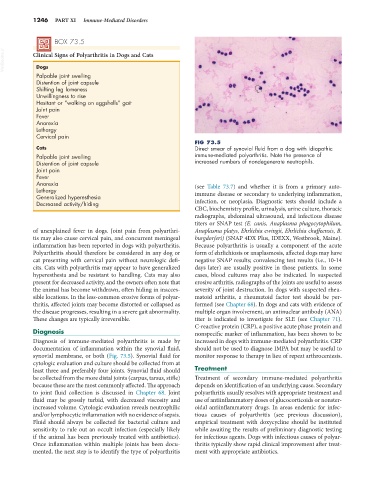Page 1274 - Small Animal Internal Medicine, 6th Edition
P. 1274
1246 PART XI Immune-Mediated Disorders
BOX 73.5
VetBooks.ir Clinical Signs of Polyarthritis in Dogs and Cats
Dogs
Palpable joint swelling
Distention of joint capsule
Shifting leg lameness
Unwillingness to rise
Hesitant or “walking on eggshells” gait
Joint pain
Fever
Anorexia
Lethargy
Cervical pain
FIG 73.5
Cats Direct smear of synovial fluid from a dog with idiopathic
Palpable joint swelling immune-mediated polyarthritis. Note the presence of
Distention of joint capsule increased numbers of nondegenerate neutrophils.
Joint pain
Fever
Anorexia (see Table 73.7) and whether it is from a primary auto-
Lethargy
Generalized hyperesthesia immune disease or secondary to underlying inflammation,
Decreased activity/hiding infection, or neoplasia. Diagnostic tests should include a
CBC, biochemistry profile, urinalysis, urine culture, thoracic
radiographs, abdominal ultrasound, and infectious disease
titers or SNAP test (E. canis, Anaplasma phagocytophilum,
of unexplained fever in dogs. Joint pain from polyarthri- Anaplasma platys, Ehrlichia ewingii, Ehrlichia chaffeensis, B.
tis may also cause cervical pain, and concurrent meningeal burgdorferi) (SNAP 4DX Plus, IDEXX, Westbrook, Maine).
inflammation has been reported in dogs with polyarthritis. Because polyarthritis is usually a component of the acute
Polyarthritis should therefore be considered in any dog or form of ehrlichiosis or anaplasmosis, affected dogs may have
cat presenting with cervical pain without neurologic defi- negative SNAP results; convalescing test results (i.e., 10-14
cits. Cats with polyarthritis may appear to have generalized days later) are usually positive in those patients. In some
hyperesthesia and be resistant to handling. Cats may also cases, blood cultures may also be indicated. In suspected
present for decreased activity, and the owners often note that erosive arthritis, radiographs of the joints are useful to assess
the animal has become withdrawn, often hiding in inacces- severity of joint destruction. In dogs with suspected rheu-
sible locations. In the less-common erosive forms of polyar- matoid arthritis, a rheumatoid factor test should be per-
thritis, affected joints may become distorted or collapsed as formed (see Chapter 68). In dogs and cats with evidence of
the disease progresses, resulting in a severe gait abnormality. multiple organ involvement, an antinuclear antibody (ANA)
These changes are typically irreversible. titer is indicated to investigate for SLE (see Chapter 71).
C-reactive protein (CRP), a positive acute phase protein and
Diagnosis nonspecific marker of inflammation, has been shown to be
Diagnosis of immune-mediated polyarthritis is made by increased in dogs with immune-mediated polyarthritis. CRP
documentation of inflammation within the synovial fluid, should not be used to diagnose IMPA but may be useful to
synovial membrane, or both (Fig. 73.5). Synovial fluid for monitor response to therapy in lieu of repeat arthrocentesis.
cytologic evaluation and culture should be collected from at
least three and preferably four joints. Synovial fluid should Treatment
be collected from the more distal joints (carpus, tarsus, stifle) Treatment of secondary immune-mediated polyarthritis
because these are the most commonly affected. The approach depends on identification of an underlying cause. Secondary
to joint fluid collection is discussed in Chapter 68. Joint polyarthritis usually resolves with appropriate treatment and
fluid may be grossly turbid, with decreased viscosity and use of antiinflammatory doses of glucocorticoids or nonster-
increased volume. Cytologic evaluation reveals neutrophilic oidal antiinflammatory drugs. In areas endemic for infec-
and/or lymphocytic inflammation with no evidence of sepsis. tious causes of polyarthritis (see previous discussion),
Fluid should always be collected for bacterial culture and empirical treatment with doxycycline should be instituted
sensitivity to rule out an occult infection (especially likely while awaiting the results of preliminary diagnostic testing
if the animal has been previously treated with antibiotics). for infectious agents. Dogs with infectious causes of polyar-
Once inflammation within multiple joints has been docu- thritis typically show rapid clinical improvement after treat-
mented, the next step is to identify the type of polyarthritis ment with appropriate antibiotics.

